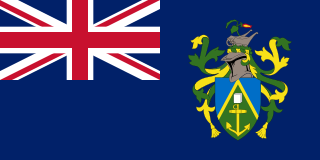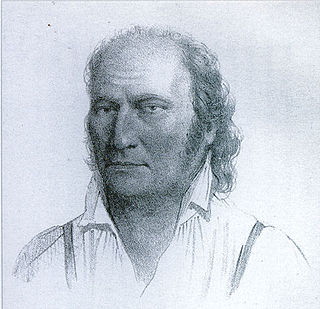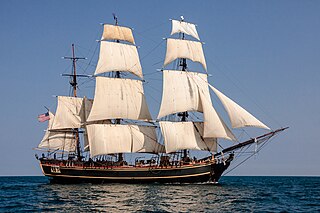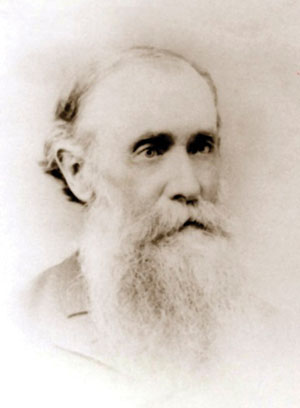
The Pitcairn Islands, officially the Pitcairn, Henderson, Ducie and Oeno Islands, is a group of four volcanic islands in the southern Pacific Ocean that form the sole British Overseas Territory in the Pacific Ocean. The four islands—Pitcairn, Henderson, Ducie and Oeno—are scattered across several hundred miles of ocean and have a combined land area of about 18 square miles (47 km2). Henderson Island accounts for 86% of the land area, but only Pitcairn Island is inhabited. The islands nearest to the Pitcairn Islands are Mangareva at 688 km to the west and Easter Island at 1,929 km to the east.

The Pitcairn Islands consist of four islands: Pitcairn Island, Henderson Island, and two coral atolls, Oeno Island and Ducie Island.

Mutiny on the Bounty is a 1932 novel by Charles Nordhoff and James Norman Hall, based on the mutiny against Lieutenant William Bligh, commanding officer of the Bounty in 1789. It has been made into several films and a musical. It was the first of what became The Bounty Trilogy, which continues with Men Against the Sea, and concludes with Pitcairn's Island.

The mutiny on the Royal Navy vessel HMS Bounty occurred in the South Pacific Ocean on 28 April 1789. Disaffected crewmen, led by acting-Lieutenant Fletcher Christian, seized control of the ship from their captain, Lieutenant William Bligh, and set him and eighteen loyalists adrift in the ship's open launch. The mutineers variously settled on Tahiti or on Pitcairn Island. Bligh navigated more than 3,500 nautical miles in the launch to reach safety and began the process of bringing the mutineers to justice.

John Adams, known as Jack Adams, was the last survivor of the Bounty mutineers who settled on Pitcairn Island in January 1790, the year after the mutiny. His real name was John Adams, but he used the name Alexander Smith until he was discovered in 1808 by Captain Mayhew Folger of the American whaling ship Topaz. His children used the surname "Adams".

Adamstown is the capital of the Pitcairn Islands, and the only settlement on the Pitcairn Islands, the only British Overseas Territory that is located in the Pacific Ocean.

The history of the Pitcairn Islands begins with the colonization of the islands by Polynesians in the 11th century. Polynesian people established a culture that flourished for four centuries and then vanished. They lived on Pitcairn and Henderson Islands, and on Mangareva Island 540 kilometres (340 mi) to the northwest, for about 400 years.

Fletcher Christian was an English sailor who led the mutiny on the Bounty in 1789, during which he seized command of the Royal Navy vessel HMS Bounty from Lieutenant William Bligh.

HMS Pandora was a 24-gun Porcupine-class sixth-rate post ship of the Royal Navy launched in May 1779. The vessel is best known for its role in hunting down the Bounty mutineers in 1790, which remains one of the best-known stories in the history of seafaring. Pandora was partially successful by capturing 14 of the mutineers, but wrecked on the Great Barrier Reef on the return voyage in 1791. HMS Pandora is considered to be one of the most significant shipwrecks in the Southern Hemisphere.
Pitcairn Islanders, also referred to as Pitkerners and Pitcairnese, are the native inhabitants of the Pitcairn Islands, a British Overseas Territory including people whose families were previously inhabitants and maintaining cultural connections. Most Pitcairn Islanders are descendants of the Bounty mutineers.

HMS Bounty, also known as HM Armed Vessel Bounty, was a small merchant vessel that the Royal Navy purchased in 1787 for a botanical mission. The ship was sent to the South Pacific Ocean under the command of William Bligh to acquire breadfruit plants and transport them to the West Indies to be grown as food to feed the West Indies' large population of slaves. That mission was never completed owing to a 1789 mutiny led by acting lieutenant Fletcher Christian, an incident now popularly known as the Mutiny on the Bounty. The mutineers later burned Bounty while she was moored at Pitcairn Island in the Southern Pacific Ocean in 1790. An American adventurer helped land several remains of Bounty in 1957.

The Bounty Bible is a Bible that is thought to have been used on HMS Bounty, the ship famed for the Mutiny on the Bounty.

John I. Tay was a Seventh-day Adventist missionary who was known for his pioneering work in the South Pacific. It was through his efforts that most of the inhabitants of Pitcairn Island were converted to Adventism, and that the General Conference of Seventh-day Adventists purchased the Pitcairn schooner for missionary work in the South Pacific.

Pitcairn was a schooner built in 1890 for the Seventh-day Adventist Church for use in missionary work in the South Pacific. After six missionary voyages, the schooner was sold in 1900 for commercial use, and renamed Florence S. She was lost by stranding on the island of Mindoro, Philippine Islands, on 17 October 1912.

The complement of HMS Bounty, the Royal Navy ship on which a historic mutiny occurred in the south Pacific on 28 April 1789, comprised 46 men on its departure from England in December 1787 and 44 at the time of the mutiny, including her commander Lieutenant William Bligh. All but two of those aboard were Royal Navy personnel; the exceptions were two civilian botanists engaged to supervise the breadfruit plants Bounty was tasked to take from Tahiti to the West Indies. Of the 44 aboard at the time of the mutiny, 19 were set adrift in the ship's launch, while 25, a mixture of mutineers and detainees, remained on board under Fletcher Christian. Bligh led his loyalists 3,500 nautical miles to safety in the open boat, and ultimately back to England. The mutineers divided—most settled on Tahiti, where they were captured by HMS Pandora in 1791 and returned to England for trial, while Christian and eight others evaded discovery on Pitcairn Island.
Rosalind Amelia Young was a historian from Pitcairn Islands.

Teraura, also Susan or Susannah Young, was a Tahitian woman who settled on Pitcairn Island with the Bounty Mutineers. She took part in Ned Young's plot to murder male Polynesians who had travelled on HMS Bounty and killed Tetahiti. A tapa maker, examples of her craft are found in the British Museum and at Kew Gardens.

Mauatua, also Maimiti or Isabella Christian, also known as Mainmast, was a Tahitian tapa maker, who settled on Pitcairn Island with the Bounty mutineers. She married both Fletcher Christian and Ned Young, and had children with both men. Fine white tapa, which was her specialty, is held in the collections of the British Museum and the Pitt Rivers Museum, amongst others.
Bounty Museum, also Bounty Folk Museum, is the original museum on Norfolk Island, an Australian external territory in the Pacific.


















